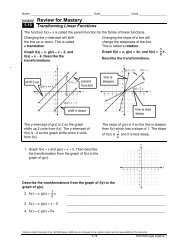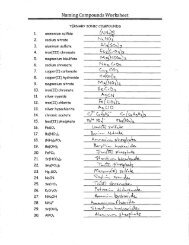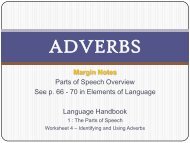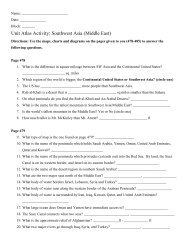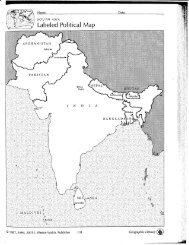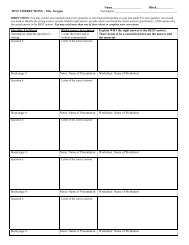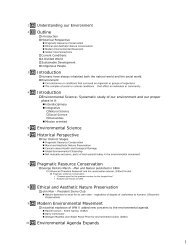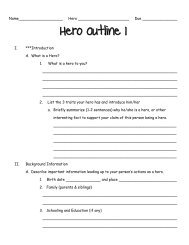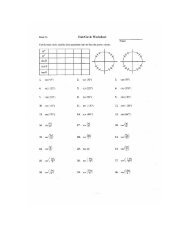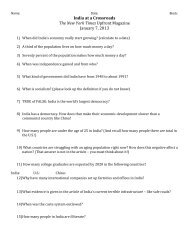Physical Science Practice Test 1
Physical Science Practice Test 1
Physical Science Practice Test 1
Create successful ePaper yourself
Turn your PDF publications into a flip-book with our unique Google optimized e-Paper software.
<strong>Physical</strong> <strong>Science</strong>1.1.2The student actively engages ininvestigations, including developingquestions, gathering and analyzing data,and designing and conducting research.
1) Sara and Jacob designed an experiment to test the effectsof increased mass on the speed of a remote control car.Which of the following is the independent variable in theirexperiment?A. The mass added to the remote control car.B. The speed of the remote control car.C. The distance the remote control car travelsD. The person driving the remote control car.<strong>Physical</strong> <strong>Science</strong> 1.1.2
2) Dave and Ryan designed an experiment todetermine if crushed ice cools water faster than cubedice. The dependent variable in their experiment isA. the type of ice added to the water.B. the temperature of the water.C. the rate of temperature change.D.the final temperature of the water.<strong>Physical</strong> <strong>Science</strong> 1.1.2
3) Sara and Jacob designed an experiment totest the effect of the mass on the acceleration ofthe remote control car. Which of the followingis the best hypothesis for their experiment?A. When the acceleration of the remote control car increase,the mass of the remote control car decreases.B. If the acceleration of the remote control car decreases,the mass of the remote control car decreases.C. The acceleration of the remote control car is related tothe mass of the remote control car.D. If mass is added to a remote control car, then theacceleration of the remote control car decreases.<strong>Physical</strong> <strong>Science</strong> 1.1.2
<strong>Physical</strong> <strong>Science</strong>1.1.3The student actively engages in usingtechnological tools and mathematicsin their own scientific investigations.
1) Which instrument would be best to useto measure 212 milliliters of a liquid?A. beakerB. test tubeC. Erlenmeyer flaskD.graduated cylinder<strong>Physical</strong> <strong>Science</strong> 1.1.3
Table 1: The density of five items.itemnumberMass(g)volume(mL)density(g/mL)1 22 11 22 24 12 23 21 10 2.14 25 12 2.15 20 9 2.22) Determine themean of the massesfor items 1-5 listed inTable 1?A.22.4 gB.22.4 mLC.22.5 gD.22.4 g/mL<strong>Physical</strong> <strong>Science</strong> 1.1.3
Table 1: Fuel Efficiency of Three Grades ofGasolineGasolineGradeOctaneRatingRegular 87Plus 89Premium92Fuel Efficiency(miles per gallon)Trial 1 22.5Trial 2 22.9Trial 3 21.9Trial 1 22.8Trial 2 23.1Trial 3 23.5Trial 1 24.6Trial 2 24.7Trial 3 24.63) Carla measured the fuelefficiency of three grades ofgasoline with different octaneratings and recorded herresults in Table 1.Which conclusion is supportedby Carla’s data?A. Cars are more fuel efficient when traveling at higher rates ofspeed.B. A car running on high-octane gasoline travels faster thanwhen running on low-octane gasoline.C. Cars that use gasoline with a lower octane rating will run fora longer period of time.D. A car is more fuel-efficient when it runs on high-octanegasoline than when it runs on low-octane gasoline.<strong>Physical</strong> <strong>Science</strong> 1.1.3
<strong>Physical</strong> <strong>Science</strong>2A.1.1The student understands that atoms, thefundamental organizational unit of matter, arecomposed of subatomic particles. Chemists areprimarily interested in the protons, electrons,and neutrons found in the atom..
1) A neutral atom of gold (Au) has a mass number of 197and has 118 neutrons. How many electrons does this goldatom have?A. 79 electronsB. 118 electronsC. 197 electronsD. 315 electrons<strong>Physical</strong> <strong>Science</strong> 2A.1.1
2) A neutral atom of sulfur (S) has a mass number of 65 and anatomic number of 32. How many neutrons does this sulfur atomhave?A. 33 neutronsB. 65 neutronsC. 32 neutronsD. 97 neutrons<strong>Physical</strong> <strong>Science</strong> 2A.1.1
3) An atom is composed of subatomicparticles. Each subatomic particle hasspecific properties. Which of the followingis the correct information about protons?A. Protons are negatively charged; and are locatedoutside the nucleusB. Protons are positively charged; and are locatedoutside the nucleus.C. Protons are positively charged; and are locatedinside the nucleus.D.Protons are neutral; and are located inside thenucleus.<strong>Physical</strong> <strong>Science</strong> 2A.1.1
B4) Which structurein Figure 1represents anelectron?A. Structure AB. Structure BC. Structure CD. Structure DAFigure 1DC<strong>Physical</strong> <strong>Science</strong> 2A.1.1
<strong>Physical</strong> <strong>Science</strong>2A.2.1The student understands chemists usekinetic and potential energy to explain thephysical and chemical properties of matteron earth that may exist in any of these threestates: solids, liquids, and gases.
1) The kinetic-molecular theory states thatthe particles of matter are in constantmotion. Which of the followingstatements is true?A. Particles of a substance in liquid phase have lesskinetic energy than those of the solid phase.B. Particles of a substance in gaseous phase have lesskinetic energy than those of the liquid phase.C. Particles of a substance in solid phase have lesskinetic energy than those of the gaseous phase.D. Particles of a substance in solid phase have moreenergy than those in a liquid phase.<strong>Physical</strong> <strong>Science</strong> 2A.2.1
2) A glass of water is composedof billions of water molecules.When you put that glass ofwater in the refrigerator iscools. As the water is cooledfrom 20 o Celsius to 4 o Celsiusthe molecules of waterA. lose kinetic energy and slow down.B. gain kinetic energy and slow down.C. lose kinetic energy and move faster.D. gain kinetic energy and move faster.<strong>Physical</strong> <strong>Science</strong> 2A.2.1
3) When water freezes to ice, the ice floats. The mostaccurate explanation of this phenomenon isA) Solid water is more dense than liquid waterB) As water freezes the density decreases.C) As water freezes the density increases.D)Liquid water is less dense than solid water.<strong>Physical</strong> <strong>Science</strong> 2A.2.1
<strong>Physical</strong> <strong>Science</strong>2A.2.2The student understands the periodic tablelists elements according to increasing atomicnumber. This table organizes physical andchemical trends by groups, periods and subcategories.<strong>Physical</strong> <strong>Science</strong> 2A.2.2
ABFigure 11) Figure 1 shows a portion of a periodic table. Identify thesegments labeled A and B.A) And B are both periods.B) A is a period and B is a groupC) A and B are both groups.D) A is a group and B is a period.<strong>Physical</strong> <strong>Science</strong> 2A.2.2
2) Moving from left to right across a row of the periodic table,which of the following values increases by exactly one fromelement to element?A) isotope numberB) atomic numberC) atomic mass unitD) mass number <strong>Physical</strong> <strong>Science</strong> 2A.2.2
3) Study the periodic table above. Which of the followingelements has only one valence electron?A) Lithium (Li)B) Oxygen (O)C) Calcium (Ca)D) Carbon (C)<strong>Physical</strong> <strong>Science</strong> 2A.2.2
<strong>Physical</strong> <strong>Science</strong>2A.2.3The student understands chemical bonds result whenvalence electrons are transferred or shared betweenatoms. Breaking a chemical bond requires energy.Formation of a chemical bond releases energy. Ioniccompounds result from atoms transferring electrons.Molecular compounds result from atoms sharingelectrons.For example, carbon atoms can bond to each other inchains, rings, and branching networks. Branchednetwork and metallic solids also result from bonding.<strong>Physical</strong> <strong>Science</strong> 2A.2.3
LiCFNeFigure 21) Study the electron dot diagrams for lithium, carbon, fluorineand neon in Figure 2. Choose the statement that correctlyidentifies the most stable of the elements.A) Lithium is the most stable element because it has to lose only oneelectron to achieve a stable configuration.B) Carbon is the most stable element because is can form four bonds.C) Fluorine is the most stable element because it has to gain only oneelectrons to achieve a stable configuration.D) Neon is the most stable element because it has eight valence electrons.<strong>Physical</strong> <strong>Science</strong> 2A.2.3
2) The formation of an ionic bond involves theA) transfer of neutrons.B) transfer of electrons.C) transfer of protons.D) sharing of electrons.<strong>Physical</strong> <strong>Science</strong> 2A.2.3
3)Which of the following formulasrepresents a compound whose moleculescontain a triple covalent bond?A) N NB) O O OC) O 3D) SO 3<strong>Physical</strong> <strong>Science</strong> 2A.2.3
4) Based on the location of sodium (Na) in the Periodic Table, onecould predict that sodium will most likely formA) an anion when is reacts with chlorine (Cl).B) a cation when it reacts with chlorine (Cl).C) a covalent bond when it reacts with chlorine (Cl).D) sodium will not react with chlorine because it is stable.<strong>Physical</strong> <strong>Science</strong> 2A.2.3
5) Carbon (C) and oxygen (O) are both nonmetals Theyare located on the same side of the Periodic Table.Based on this information, what type of bond formswhen they react to form carbon dioxide?A) a covalent bondB) an ionic bondC) they will not reactD) a hydrogen bond<strong>Physical</strong> <strong>Science</strong> 2A.2.3
<strong>Physical</strong> <strong>Science</strong>2A.3.1The student understands a chemical reaction occurswhen one or more substances (reactants) react toform a different chemical substance(s) (products).There are different types of chemical reactions all ofwhich demonstrates the law of Conservation ofMatter and Energy.<strong>Physical</strong> <strong>Science</strong> 2A.3.1
1) In terms of energy, how would you classify thefollowing chemical reaction?2Cu + O 2 2CuO + energyA)endothermicB) exothermicC) both endothermic and exothermicD)neither endothermic nor exothermic<strong>Physical</strong> <strong>Science</strong> 2A.3.1
2Cu + O 2 2CuO + energy2) The substances that are present before a chemicalreaction takes place are calledA) products.B) reactants.C) CoefficientsD) elements..<strong>Physical</strong> <strong>Science</strong> 2A.3.1
C 6 H 12 O 6 + 6 O 2 6 CO 2 + 6 H 2 O + energy3) The total amount of energy before and after achemical reaction is the same. Thus, energy isA) created.B) destroyed.C) conserved.D) the same as mass.<strong>Physical</strong> <strong>Science</strong> 2A.3.1
<strong>Physical</strong> <strong>Science</strong>2B.2.2The student understands the first law ofthermodynamics states the total energy of a substance(the sum of all the kinetic and potential energies of itsconstituent molecules) will change only is heat isexchanged with the environment or work is done on orby the substance. In any physical interaction, the totalenergy in the universe is conserved.<strong>Physical</strong> <strong>Science</strong> 2B.2.2
1) The power of a machine measuresA) its rate of doing work.B) its strength.C) the force it producesD) the work it does..<strong>Physical</strong> <strong>Science</strong> 2B.2.2
2) Which of the following materials conducts heat well?A) glassB) plasticC) metalD) wood<strong>Physical</strong> <strong>Science</strong> 2B.2.2
Figure 15-13) The kinetic energy of the pendulum bob in Figure15-1 increases the most between locationsA) A and B. C) B and D.B) A and C. D) C and D.<strong>Physical</strong> <strong>Science</strong> 2B.2.2
4) To which of the following doesthe first law of thermodynamicsapply?A) heating objectsB) transferring thermalenergyC) doing work on a systemD) all of the above<strong>Physical</strong> <strong>Science</strong> 2B.2.2
Heat5) The second law of thermodynamics states thatthermal energy can flow from colder objects to hotterobjectsA) by convection.B) only if work is done on the system.C) spontaneously.D) when thermal expansion takes place.<strong>Physical</strong> <strong>Science</strong> 2B.2.2
6) In which of the following is no work done?A) climbing stairs C) pushing a shopping cartB) lifting a box D) pushing a brick wall<strong>Physical</strong> <strong>Science</strong> 2B.2.2
7) The energy of motion is calledA) kinetic energy. C) thermal energy.B) potential energy. D) work.<strong>Physical</strong> <strong>Science</strong> 2B.2.2
8) The energy stored in gasoline isA) chemical energy. C) mechanical energy.B) electromagnetic energy. D) nuclear energy.<strong>Physical</strong> <strong>Science</strong> 2B.2.2
Answers• 1.1.21) A2) C3) D• 1.1.31) D2) A3) D
Answers• 2A.1.11) A2) A3) C4) D• 2A.2.11) C2) A3) B
Answers• 2A.2.21) B2) B3) A• 2A.2.31) D2) B3) A4) B5) A
• 2A.3.11) B2) B3) CAnswers• 2B.2.21) D2) C3) B4) D5) B6) D7) A8) A



